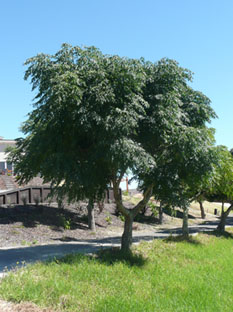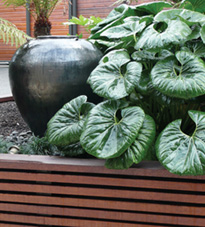Here at Flourish, our landscape design experts are not only skilled in the field of garden design, we also know a great deal about plant life. This comes from a combination of professional knowledge and personal experience; after all, we're gardeners too! Each month we spotlight a different plant species, keeping our valued clients well informed about their planting options.
Check out this months plant below.
Acer palmatum 'Bloodgood'
A strong growing, upright Maple tree with blackish red stems and the deepest purple, red foliage, holding right through summer. It has fiery red autumn colours and seed capsules. A small to medium tree perfect for small gardens. Deciduous, grows approximately to 5m.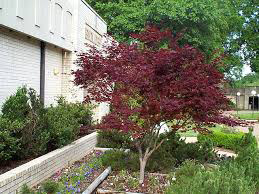
Hakonechola mcra albo-striata - Japanese Temple Grass
This form of Japanese Temple Grass has elegant, cascading broad leaves edged with a soft white variegation. Great for brightening up a shady corner. It thrives in a position that has a combination of shade and sun during some part of the day. Fully grown it gets aprox 500-600mm wide and is winter dormant, which means the plants that die down (usually to ground level) during the autumn and winter months.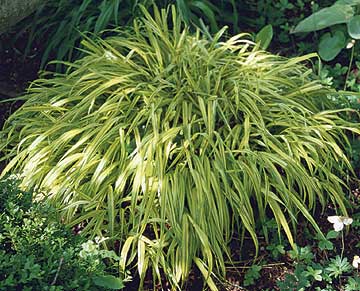
Podocarpus gracilor - Fern pine
These trees are great as a specimen feature tree or street tree where space allows. They can be trimmed as a hedge or screen, or shaped into topiary forms with a little judicious pruning. Graceful arching habit to the branches with fine foliage. Hardy.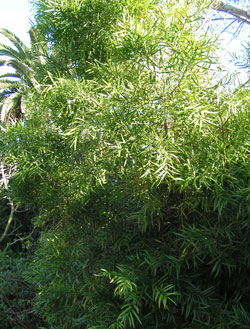
Zephyranthes candida - Fairy lily
These little bulbs do well in full sun to semi shade situation in a well drained but moist soil. Semi-hardy clump-forming bulbous perennial with chive-like leaves. After rain, huge, crocus-like flowers begin to appear and continue for months. Also ideal for containers, edging or massed planted in drifts amongst the garden. Size (fully grown) 30 x 30cm.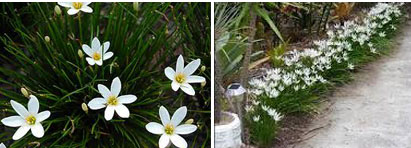
Astelia banksii - Wharawhara
Astelia banksii is found in the northern half of the North Island, generally on coastal cliffs and coastal low land forests, making it a great choice for coastal and seaside gardens. It is one of the best Astelia's for Auckland as it is naturally found here. It is less susceptible to phytophthora (a fungal disease causing root rot ) than Astelia chathamica.Astelia's are the perfect foliage plant, its slender strands of silver foliage need little care. It will grow to form a tight, compact and tidy clump that around 1.3m high and 1.3m wide. It will grow in full sun or shade, it requires good drainage but is frost tender. Astelia's tolerate very dry conditions, they are perfect for planting in large groups under large trees and in containers and planters.

Camellia japonica 'Night rider'
A stunning japonica Camellia featuring spectacular dark red new growth and small waxy black/red coloured flowers. It is a late winter-flowering variety. Its compact growth makes 'Night Rider' ideal as a hedge or a stand alone feature planted in a shady part of the garden. It is also suitable for containers. Camellia 'Night rider' grows to aproximately 2.5m high x 2m wide. Camellias are reasonably tolerant of a wide range of soil conditions but respond vigorously to ideal conditions - slightly acid, free-draining soil that is rich in humus.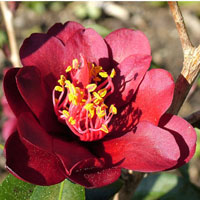
Aloe polyphylla - Spriral aloe
Aloe polyphylla is an excellent example of a plant which is a living work of art. The fleshy soft green spirals of leaves wrap around in a dramatic clock-wise or anti-clockwise direction. This succulent needs perfect drainage and all day sun. It looks superb in a container or large feature pot.In the garden, surround Aloe polyphylla with gravel or stones and grow it alongside other smaller succulents or with dwarf, drought tolerant grasses such as dramatic Ophiopogon ‘Black Dragon’. A once-rare, and possibly the most spectacular, of all South African aloes.
Lomandra tanika
I adore New Zealands native tussocks and grasses, their colour and form in the landscape is a beautiful sight. A number of years ago stopped planting most of them because I hated the way they started to rot and die only after the first few months. Natives and grasses mostly come from cool, alpine climates with very low humidity most of the year and loose, gravelly soils. Here in Auckland in the North Island we have warm, humid conditions and richer, soils and they can't handle it. I now happily use for dry, sunny areas with poor soils the Mat Rushes, Lomandra, namely Lomandra tanika. These are great aussie plants, they look like grasses but they're not grasses.They can handle extreme drought and frost and can thrive in full sun and partial shade. They grow to around 900mm wide. They have masses of creamy yellow tiny flowers among the soft spikes in spring and retain their bushy bright green tussock-like foliage all year round, for years. A very low maintenance option for your garden.
Canna lilies
Love them or loathe them Canna lilies make a bold, colourful addition to any garden. These subtropical perennials grow well in a frost-free temperate climate. Canna's are available in a range of vibrant colours that look wonderful when planted in groups together or mingled in between other subtropical plants. Flowers come in shades of red, pink, orange, cream, bicolours and some with stripes and spots. The leaves are typically solid green but some cultivars have brownish, maroon, or even variegated leaves.Canna's grow best in full sun for maximum flower production. They love being fed and watered liberally. These beauties flower non stop from late spring until they are defoliated by frosts during winter. Cut back hard in August.
Ligularia reniformus - Tractor seat
If you fancy foliage like I do and have a shady, damp area of the garden, then consider planting one or more Ligularia reniformus or other wise known as tractor seat Ligularia. It has dinner plate size kidney shaped deep green leaves and is hardy and easy to grow. It does best in a shady situation, although it does tolerate the sun as long as it is watered well. Tall stems of yellow flowers appear in mid summer which I remove.It makes quite a statement in the garden. I like to plant mine under the canopy of taller palms such as Bangalow, Kentia or Nikau palms or around the base of native tree ferns. You can plant them alongside other shade loving plants such as ferns and clivia.
Rhopalostylis sapida -Nikau palm
There are so many different plants I adore all for different reasons, whether for their seasonal colour, bold foliage or interesting flowers. New Zealand natives have a huge diversity and range available for the home gardener. One of my favourites is the Nikau palm, Rhopalostylis sapida. The Nikau palm is the only palm species native to mainland New Zealand. Its natural range is coastal and lowland forest on the North Island, and on the South Island as far south as Okarito. Nikaus.Plants from the South Island and the offshore islands of the North Island have larger, more gracefully arching fronds and are popular in cultivation. The Chatham Islands form is particularly different, having a distinct juvenile form and larger fruits, and a thicker covering of fine hairs on the fronds. The New Zealand Nikau palm is very similar to Rhopalostylis baueri of the Kermadecs and Norfolk Island, which can be distinguished by its more rounded or oval fruits, and by its leaflets which are broader than those found in most populations of R. sapida.
If you would like to plant one in your garden, consider a sheltered, shady spot, the Nikau thrives on cool temperatures but is not subject to freezing weather in its natural habitat. It can survive a few degrees of frost, but it is damaged even more severely by sudden large drops in temperature even above freezing. Although relatively slow growing expect your Nikau to grow to aproximately 10 - 15m in height, but this will be over quiet a number of years, forming the trunk can take up to 15 years. It also makes an excellent pot specimen.
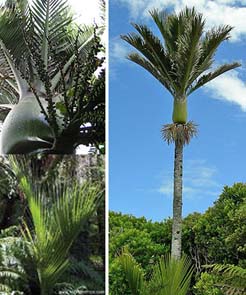
Feijoa sellowiana - Feijoa
One of my favorite edible plants are Feijoa's. The feijoa was collected in southern Brazil by a German explorer Freidrich Sellow in 1815 and introduced to Europe by French botanist and horticulturist, Dr Edouard Andre, in 1890. It was named after Brazilian botanist, Joam da Silva Feijo. Feijoas were introduced into New Zealand in the 1920`s. New Zealand's ideal climate produced large fruit, and few pest enabled feijoa's to be grown organically (chemical sprays therefore are not applied to New Zealand fruit, making NZ feijoa's some of the most natural fruit available). The New Zealand season runs from late March to June.This versatile plant makes a great screening hedge. Make sure you plant them where you can take full advantage of the stunning flowers over Christmas or the delicious fruit from autumn to early winter. The fruit has good levels of Vitamin C (50mg/100mg of flesh) and dietary fibre. One fruit will provide 23% of an adult's daily need.
See the varieties available from the 'Incredible Edible' website. A superb nursery that offers an exciting range of unusual fruiting plants that look great in any garden setting. They will all flower and of course they will all provide you with fresh healthy fruit.
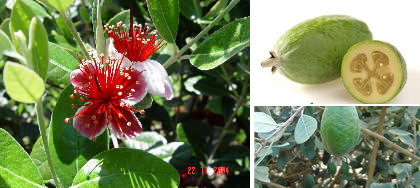
Melia Azederach - Indian Bead tree
Autumn is here and time for planting your favorite ornamental trees. One of my personal favourites for both small and large gardens is Melia Azederach or otherwise known as the 'Chinaberry', 'Bead tree' or 'Persian Lilac'. They provide a lovely scent in Spring, Summer shade and then allows the sun through in Winter.It is common around Northland and is a medium-sized, fast-growing umbrella-shaped tree, ideal as a lawn or patio tree for Summer shade.
Unlike most deciduous trees, the Melia, which is a member of the mostly evergreen Mahogany family, is never quite bare. In October the lots of little lilac flowers, scented like warm chocolate, appear in big bunches on the bare branches just before the leaves emerge.
The ferny leaves make a lush, dark canopy of foliage through Summer, hiding the masses of unripe berries, although the wood pigeons still seem to find them. It holds its leaves till July or sometimes August when they turn yellow and drop, only to appear again in late September and October, a matter of only six or eight weeks later.
Best of all, it brings the wood pigeons to the garden all year long.
